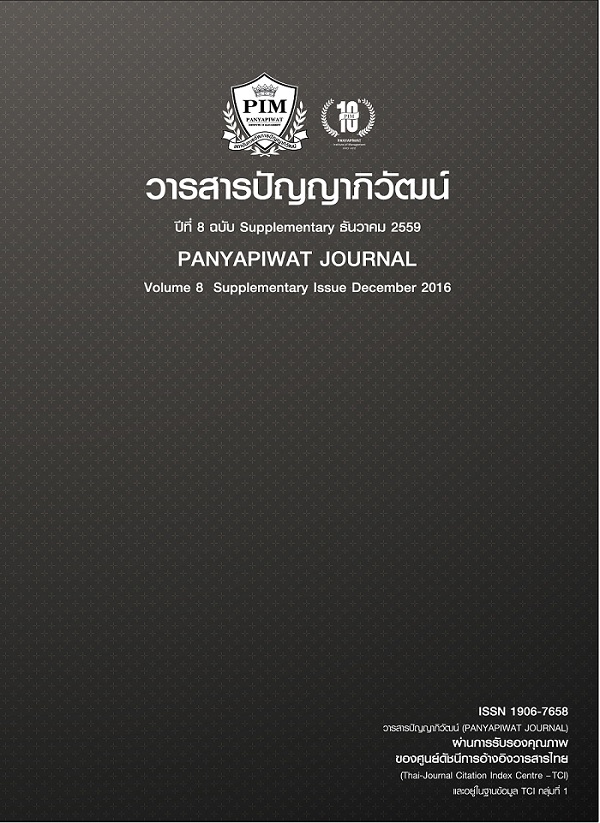THE STUDY OF AN EDO KERNEL AND M0 PARAMETER FOR A SI-SRR2
Main Article Content
บทคัดย่อ
Because of a run on high spatial resolution images, the fabulous analysis exertions in the field of Digital Image Processing (DSP), especially in single image Super Resolution Reconstruction (SI-SRR) algorithms, have ultimately inflated during this era. Hence, the uncomplicated and rapid SI-SRR algorithms have been dramatically intrigued for applying on commercial digital camera embedded equipment for instance, digital camera, smart phone, CCTV, etc. The SI-SRR based on high-frequency image prediction technique, one of the practical and effective SI-SRR algorithms, is the uncomplicated and powerful algorithm for increasing the image spatial resolution but this algorithm severely hinges upon two main factors: M0 parameter and the Edge Detection Operator (EDO) kernel. Hence, this paper rigorously enquires into the performance of this SI-SRR algorithm for 14 standard tested images for the proposing of experimentally obtaining the value of two parameters (M0 parameter and the EDO kernel), which give the highest PSNR under several environments: noiseless, several blurred environments at many blurred variances and several noisy environments at many Gaussian noise power levels.
เนื่องจากภาพที่มีความละเอียดสูงยังมีความต้องการในการประยุกต์ใช้งาน ดังนั้นจึงมีการวิจัยเกี่ยวกับการประมวลผลสัญญาณภาพดิจิทัลโดยเฉพาะอย่างยิ่งเกี่ยวกับอัลกอริทึมการสร้างภาพความละเอียดสูงยิ่งที่สร้างขึ้นจากภาพความละเอียดต่ำ (SI-SRR) เพียงภาพเดียวอย่างแพร่หลายในช่วงเวลานี้ และเนื่องจากอัลกอริทึมการสร้างภาพความละเอียดสูงยิ่งแบบ SI-SRR จะมีความรวดเร็วในการคำนวณสูงและมีความซับซ้อนต่ำ ดังนั้นจึงเหมาะสำหรับประยุกต์ใช้งานกับอุปกรณ์ฝังตัวของกล้องดิจิทัลอย่างเช่นกล้องดิจิทัลทั่วไป โทรศัพท์มือถือ กล้องแบบ CCTV เป็นต้น อัลกอริทึมการสร้างภาพความละเอียดสูงยิ่งแบบ SI-SRR ที่กล่าวถึงในบทความนี้จะเป็นอัลกอริทึมที่ใช้เทคนิคการประมาณข้อมูลความถี่สูงของภาพ ถึงแม้ว่าอัลกอริทึมดังกล่าวจะมีประสิทธิภาพสูงและเหมาะสำหรับการประยุกต์ใช้งานแต่ประสิทธิภาพของอัลกอริทึมการสร้างภาพความละเอียดสูงยิ่งแบบ SI-SRR แบบนี้จะขึ้นอยู่กับตัวแปรหลักที่ใช้ในการคำนวณจำนวนสองตัวคือตัวแปร M0 และค่าเคอร์เนลของ EDO ดังนั้นบทความนี้จะนำเสนอผลการศึกษาของอัลกอริทึมการสร้างภาพความละเอียดสูงยิ่งแบบ SI-SRR กับภาพทดสอบจำนวน 14 ภาพเพื่อหาค่าตัวแปร M0 และค่าเคอร์เนลของ EDO ที่ทำให้ภาพที่สร้างคืนมีค่า PSNR สูงสุดภายใต้สภาวะแวดล้อมแบบภาพที่ความละเอียดต่ำที่บันทึกได้ไม่มีสัญญาณรบกวน ภาพที่ความละเอียดต่ำที่บันทึกได้ไม่คมชัด และภาพที่ความละเอียดต่ำที่บันทึกได้มีสัญญาณรบกวน
Article Details
“ข้าพเจ้าและผู้เขียนร่วม (ถ้ามี) ขอรับรองว่า บทความที่เสนอมานี้ยังไม่เคยได้รับการตีพิมพ์และไม่ได้อยู่ระหว่างกระบวนการพิจารณาลงตีพิมพ์ในวารสารหรือแหล่งเผยแพร่อื่นใด ข้าพเจ้าและผู้เขียนร่วมยอมรับหลักเกณฑ์การพิจารณาต้นฉบับ ทั้งยินยอมให้กองบรรณาธิการมีสิทธิ์พิจารณาและตรวจแก้ต้นฉบับได้ตามที่เห็นสมควร พร้อมนี้ขอมอบลิขสิทธิ์บทความที่ได้รับการตีพิมพ์ให้แก่สถาบันการจัดการปัญญาภิวัฒน์หากมีการฟ้องร้องเรื่องการละเมิดลิขสิทธิ์เกี่ยวกับภาพ กราฟ ข้อความส่วนใดส่วนหนึ่งและ/หรือข้อคิดเห็นที่ปรากฏในบทความข้าพเจ้าและผู้เขียนร่วมยินยอมรับผิดชอบแต่เพียงฝ่ายเดียว”
เอกสารอ้างอิง
Burt, P. J. & Adelson, E. H. (1983). The Laplacian pyramid as a compact image code. IEEE Transactions on Communications, 31(4), 532-540.
Gonzalez, R. C. & Woods, R. E. (2002). Digital Image Processing. NJ, USA: Prentice-Hall.
Jeon, B., Park, R. & Yang, S. (2006). Resolution Enhancement by Prediction of the High-Frequency Image Based on the Laplacian Pyramid, Hindawi Co., EURASIP JASP. 1-11
Patanavijit, V., Pirak, C. & Ascheid, G. (2013). Experimental Performance Analysis of Image High-frequency image prediction reconstruction Based on the High-Frequency Image Prediction under Several Blurred and Noisy Environments. Proceeding of IEEE International Symposium on Communications and Information Technologies 2013 (ISCIT 2013), ECTI Association, Samui Island, Thailand. (pp. 469-474)
Patanavijit, V., Pirak, C. & Ascheid, G. (2014). A Performance Impact of An Edge Kernel for The High-Frequency Image Prediction Reconstruction. Proceeding of IEEE International Symposium on Communications and Information Technologies 2014 (ISCIT 2014), Incheon, Korea. (pp. 484-488)


